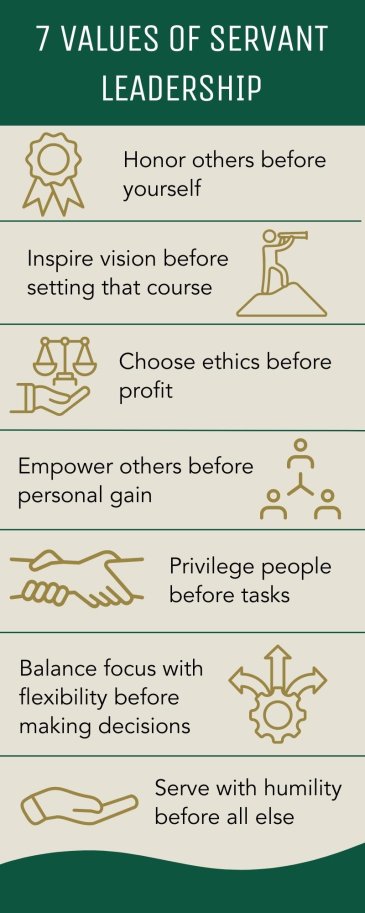
What do leaders like George Washington, Abraham Lincoln, and Martin Luther King Jr. have in common? It’s not one thing, but rather a commitment to the key values that constitute being not just an effective leader — but a servant leader committed to helping others and transforming the world for the better.
The results of servant leadership are exponential: by leading as a servant, you multiply success and satisfaction — personal and professional, for you and your colleagues — above and beyond the limits of traditional leadership outcomes.
Here are seven principles — and how to apply them in word and in deed — that will exponentially multiply your effectiveness as a leader. Study them. Practice them. Make them a lifestyle. Teach them to others. Then see the remarkable results.
7 Key Principles of Servant Leadership
Jump directly to an area of interest using the outline below:
- Honor Others (Before Yourself)
- Inspire Vision (Before Setting The Course)
- Choose Ethics (Before Profit)
- Empower Others (Before Personal Gain)
- Privilege People (Before Tasks)
- Balance Focus With Flexibility (Before Making Decisions)
- Serve With Humility (Before All Else)

1: Honor Others (Before Yourself)
Albert Einstein once said, “I speak to everyone the same way, whether he is a garbage man or the president of the university.” This simple statement perfectly encapsulates the concept of purposefully honoring others before yourself. By speaking to everyone as if they are genuinely important, no matter their position in life, Einstein is demonstrating genuine respect for all people. Respect defines the underlying attitude of a servant leader.
__________
Who are you called to be?
Pursue your purpose at PLNU.
__________
Let’s bring this concept into focus: a member of your team approaches you with the confession that they have lost sight of the purpose behind his or her work. If you respond with criticism, this damages far more than the relationship. Not only does it ruin your approachability as their leader, but it smothers internal motivation — which ultimately hurts productivity of the individual and team.
However, if you acknowledge and affirm a concern like this, showing gratitude and respect for their vulnerability, you have taken the first step towards cultivating a loyal team member with a heart-level passion for their work.
How to Honor Others
- Affirm dignity by recognizing and responding to the needs of your team
- Actively resolve issues; never wait for things to just get better
- Respect people of all positions through word and behavior
You've felt a desire for something more, to become the leader you've been called to be.
2: Inspire Vision (Before Setting The Course)
In a humbling moment that will forever be preserved, Helen Keller wrote, “The only thing worse than being blind is having sight with no vision.”
Daily, leaders around the world are going 100 miles per hour in no specific direction and getting nowhere. But great leaders work to establish a vision that goes far beyond what they can see — and full buy-in from their team. Vision from leadership and buy-in from teams produce an inspiring atmosphere where nearly any goal becomes possible.
The second value of Servant Leadership is to inspire vision before setting the course. This concept is often missed in two different ways — both of which can dramatically affect the outcome.
How to Set Vision in Your Company as a Leader
The first obstacle is when leaders fail to set a vision before taking action. These organizations end up moving very quickly, but the lack of direction jeopardizes the entire investment. Beyond leaving a team directionless and disconnected, it prevents leadership from ever measuring success in a meaningful way.
The second way leaders stumble in setting vision is when they fail to cultivate buy-in for their vision. When this happens, teams become despondent and unable to recognize the deeper purpose and value of their work.
A true servant leader addresses both failures, by first modeling a vision for the organization, and then inspiring a team to share that vision. By doing this, you’re allowing your team to take ownership of their unique contributions to pursuing the vision. This creates the opportunity to instill the “what” and the “how” of your vision, fueled by the “why.”
The biggest obstacle to inspiring a vision is recognizing how your organization can improve. Spend time considering a vision for growth and improvement, boldly communicate your vision, and help your team understand why it matters to them.
A true servant leader addresses both failures, by first modeling a vision for the organization, and then inspiring a team to share that vision.
There are few examples that compare to Steve Jobs’ relentless pursuit of a vision. Our broader culture now associates him with visionary thinking. He started as a kid who had a vision, and built Apple into one of the most powerful brands and influential companies in the 20th century. All of that because there was one man who knew how to lead people and how to inspire them to share in his vision.
His dreams weren’t carried out in one day, nor on his own. But what he did do was work persistently toward each goal, and once fulfilled, he set out to achieve his next visionary pursuit. His vision demanded growth. And by inspiring people to share in his vision, he achieved the success he could have only dreamed about otherwise.
What vision have you imagined, and how will you inspire your organization to share that vision?
How to Inspire Vision
- Model the way for your team
- Help your team realize how each person’s role contributes to a larger picture
- Be sure to share not only the “what” and “how” of your vision, but also the “why”
3: Choose Ethics (Before Profit)
“A good name is to be chosen over great riches,” according to the book of Proverbs. Over the last 2,000+ years, millions of successful leaders have learned the practical truth of this proverb.
There is no price you can pay for integrity, but a lack of integrity can be costly. While Christian teachings emphasize this virtue, almost every other major religion also has a proverb or parable promoting this concept. This leads us to the conclusion that integrity counts.

Over the last few decades, we’ve witnessed what seems to be countless organizational scandals, from major corporations to churches and non-profits. Altruism, it would seem, doesn’t protect an organization from wrongdoing.
The central theme across these scandals is a lack of integrity and moral grounding by one or more leaders. But integrity doesn’t erode in a day. Few, if any, leaders ever think, “I am going to grow powerful someday and scam thousands of people by bending or ignoring the rules.” In other words, leaders don’t often produce a major scandal overnight. It’s daily decisions that lead up to these infamous occasions. This is why it’s so important for you as a leader to be explicit regarding the non-negotiables in your life and in your business.
Making Ethical Business Decisions as a Servant Leader
Business ethics must be practiced daily. There is an immeasurable value that moral character brings to leadership. Great leaders prioritize the value of character over profit, and so they refuse to take advantage of opportunities for dishonest gain. They also recognize that in the long run, acting with integrity ultimately results in greater opportunities for lasting success — and reduces the long-term risk of the organization as a whole.
The founder of Chick-fil-A, Truett Cathy, is a classic example of someone who practiced a personal non-negotiable, risking potential profit. He has experienced exceptional success he might never have seen if he had put profit first.
Cathy made a values-driven decision when he started his restaurant. He decided to allow his employees the freedom to observe a day of rest, as he did, and did not operate on Sundays. He still holds to that value and Chick-fil-As everywhere operate only six days a week.
Great leaders prioritize the value of character over profit, and so they refuse to take advantage of opportunities for dishonest gain.
Critics argue that not opening on Sundays was an unwise business decision, but he held to his non-negotiable. Chick-fil-A has now posted 46 consecutive years of positive sales growth.
Cathy highlights a valuable lesson in leadership wisdom. He stuck to his ethical compass and his values and has seen consistent success as a result. That doesn’t mean that everyone holds the same values, but there are core business ethics that the majority of business leaders generally accept and follow.
So, what are the major and minor non-negotiables that you can hold onto as you lead your organization?
How to Make Ethical Choices
- Be clear on non-negotiables that define your integrity (especially with yourself)
- Identify how integrity will increase your long-term profitability or success
- Remember ethical business practices reduce long-term risk
Apply to PLNU’s MBA, Daytime Program
Focus on putting your purpose to work. Surround yourself with an emphasis on ethics and character, take part in small, intimate classes, a collaborative environment, field experience, and mentor programs.
4: Empower Others (Before Personal Gain)
“It’s amazing what you can achieve if you don’t care who gets the credit.” This quote by former President Harry S. Truman exemplifies how leaders achieve their greatest success — through the empowerment of the staff surrounding them.
We observe intangible qualities in a few leaders who intentionally create a team environment that empowers their staff to become better leaders themselves.
The Benefits of Servant Leadership
As leaders, we can cripple our organizations if we allow our teams to remain stagnant in their current patterns. The wisest and most introspective of leaders recognize the set of leaders and influencers who helped to empower their own leadership success.
Organizations eventually falter if they focus on financial gain over empowering individuals and teams. Leadership becomes the single point of failure, incapable of capturing the leverage that an empowered team creates. Even when these leaders meet financial targets, they face the time bomb of critical team members leaving for more fulfilling development opportunities.

Leaders who care about leveraging and empowering their teams create a safe environment that encourages confident decisions. This type of safety gives a team permission to take smart risks (with your guidance) and, more often than not, achieve greater outcomes.
These leaders also seek to understand the personal goals of team members, searching for the overlap between personal and organizational goals. By knowing and prioritizing these shared goals, a leader can shape team responsibilities to maximize internal motivations of each team member.
The wisest and most introspective of leaders recognize the set of leaders and influencers who helped to empower their own leadership success.
Few leaders have strategically empowered a team at the level that Abraham Lincoln did. At the start of his presidency, he surrounded himself with most of his former Republican Party rivals, because he saw the value of each leader and what they could contribute to his political objectives. Consistently, his cabinet was described as welcoming robust dissent and disagreement over even the simplest of policies.
Lincoln recognized the waste in having a team of “yes men,” instead choosing strong and insightful men who felt respected and safe to raise unpopular concerns. Because of this, he was able to form a powerful team that never got out of control, with strong and growing leaders in every department of his administration.
Had Lincoln wanted to create a team that just agreed with what he said, there is little doubt he could have made such selections. Instead, he chose to develop a team that leveraged individual strengths. He realized the greatest risk to his goals was not internal conflict and competition, but weak and subservient collaborators incapable of helping him carry out his vision for change.
What kind of team have you built around you, and what steps are you taking to empower them?
How to Empower Others
- Create a safe environment for employees to grow
- Allow for risks to be taken with growth and development of team members in mind
- Uncover and cultivate shared goals that inspire ownership of work responsibilities
5: Privilege People (Before Tasks)
Simon Sinek, a visionary in the field of living out purpose, said, “When people are financially invested, they want a return. When people are emotionally invested, they want to contribute.”
There is no greater value than a team that desires to carry out their responsibilities with passion. Such a team originates with leadership that understands and expresses the individual and collective value of their teams.
Many leaders have difficulty distinguishing how they can affirm and respect their team while still maintaining their full authority over the team. However, leaders that under-appreciate their employees — as with the previous Servant Leadership values — end up with a dissatisfied team, a culture of negativity, and sub-par workmanship. However, an easy solution to this dilemma is expressing value through respect, consideration, and simple encouragement.
The Values and Characteristics of a Servant Leader
There are ways as a leader you can show appreciation for your team, and it’s as simple as a timely word of affirmation or helping out with a small or mundane task when a team member is feeling overloaded.
Kindness towards your team creates an emotional trust in you as a leader, which produces a deep desire to contribute to your organization’s success.
It’s simple, practical things like that, that demonstrate appreciation and also show that you value the humanity of your employee, and not just their contribution to your team — that money and time aren’t more valuable to you than the well-being of your team. Kindness toward your team creates an emotional trust in you as a leader, which produces a deep desire to contribute to your organization’s success.
More Resources: 12 ways to identify and capitalize on leadership moments
Examples of Servant Leadership
As an example of leaders who define privileging people before tasks or money, Starbucks has gone to extra lengths to ensure that their employees are recognized for their human value, not simply as “human resources.”
One of the most visible expressions of this mentality is that they call their teams “partners,” not employees. By using this language, it privileges their “partners’” psychological ownership of the company, in addition to the actual ownership shared through its employee stock program.
Another example of how they privilege their people is through the intentional development of employees at every level of the company. They are one of the first major employers to decide to cover the cost for employees to finish their undergraduate degrees through Arizona State University.
They understand that if they develop their employees, those that decide to become long-term partners with them will be more committed to the organization and equipped to succeed. And those that move on to careers beyond the organization will become champions of the brand as their influence grows.

Thinking about these practical examples of privileging the people on a team, what are you doing today to tangibly privilege your own people?
How to Put People First
- Show tangible appreciation for your team — through both word and deed
- Put people first (over money and time)
- Be proactively kind to your team, routinely finding ways to encourage them and support them
6: Balance Focus With Flexibility (Before Making Decisions)
In business, the expression “out with the old, in with the new” has become a cliché. But how often do we use that phrase to justify the implementation of new programs that are already out of date or misaligned to the new organizational or industry reality? Leaders too often self-destruct when they are unwilling or unable to innovate and adapt to meet new circumstances. It is too easy for an organization to find itself “out with the old” because of a stubborn and inflexible attachment to “the old way.”
Very often, the education sector slides into this category when funding falls. Becoming technologically behind through inertia, a school’s students end up learning on outdated software or business models that can hold them back as they try to break into a high-tech workplace.
If you are reacting, you may already be too late.
However, for-profit corporations are just as guilty of this when they make decisions that are too conservative, afraid of the risk that comes with adaptation to evolving industry trends.
This risk aversion opens the organization to the greatest risk of all — irrelevance! These organizations end up missing large potential customer segments or market opportunities because leadership isn’t proactively changing to meet the industry’s future.
More Resources: How to take career risks without losing it all
Aversion to change has many origins. Sometimes, leaders possess incredible drive and become so focused on a singular goal that they fail to see that their original plan requires a new approach. Other times, leaders can get bogged down in the details of everyday tasks, missing the “10,000-foot view” that would demand change.
Remaining versatile while leading a team isn’t always easy, but it’s essential.
The power a leader carries relies on two things: the ability to keep a simultaneous pulse on both their team and the industry. No matter the size of the leadership team, the ability to recognize and respond to internal and external trends is essential. If you are reacting, you may already be too late.
Jeff Bezos is a key example of a leader who has kept a steady pulse of his organization and the industry while remaining open to the likely market evolution. Amazon has responded swiftly to emerging opportunities, rather than reacting to market threats.
When we consider Amazon, we don’t think of online books anymore. How many people saw the future of drones and automated package delivery? Probably not many. But embracing flexibility and focus is precisely how he runs the company. Where do you need to allow your focus to inspire adaptation?
How to Keep a Flexible Focus
- Be willing to abandon a path when it proves futile (recognize when decisions are being shaped by path dependency)
- Maintain the essential “10,000-foot view,” but keep track of the “on-the-ground” work
- Pay attention to market trends and proactively respond before you are forced to react
Apply to PLNU’s MBA, Evening Program
This program is for experienced working professionals who want to take control of their career by acquiring the four most important drivers of influential leadership: deep qualitative and quantitative business knowledge, wisdom in the face of difficult decisions, a powerful personal network, and inspiration to follow their purpose.
7: Serve With Humility (Before All Else)
“Humility is not thinking less of yourself, it’s thinking of yourself less.” Pastor and author Rick Warren articulates a valuable lesson for influential leadership. Pride becomes a poison to a team and a repellant to those you would seek to influence. Humility is not mere self-deprecation or a focus on shortcomings, but rather purposeful care and concern for the world around you.
Arrogance in a leader can make a leader seem unapproachable, condescending, and infallible. Failure to acknowledge mistakes will lead your team to fear admitting theirs. Without this kind of honesty, your leadership quickly becomes stunted.

Those working for such a leader stop feeling like they are safe to grow and try new things, for fear of being seen making a mistake. Such a leader may also become blind to flaws or growth opportunities. This becomes a negative model for team members, with everyone holding tightly to assumptions and old ways of doing things. Without a humble heart, every previous value of servant leadership is stunted.
We have all heard someone talk about an obstacle, challenge, or flaw and say, “It keeps me humble.” But why is that?
It’s because when a leader gives an honest assessment of oneself, they will always find new opportunities for growth. It’s how some of the greatest leaders have cultivated high-powered teams, teams that are truthful and clear-eyed in their observations.
It’s too easy for a leadership position to become an ivory tower, too far removed from the needs and the wisdom of the broader team. It takes intentional action to signal to a team that you are not distant, isolated, or too important for them.
When was the last time you cleaned the coffee pot? Gotten the mail? Stopped by someone’s desk just to chat? Small things like this help you remain approachable so that your real influence can grow.
Without a humble heart, every previous value of servant leadership is stunted.
George Washington exemplified humility in word and deed. After leading American colonists to independent self-government, elected as president, he arrived at a crossroads. He had finished two terms as president and had popular support to hold that title for the rest of his life. But he wanted to influence the future of the new nation and made a decision that modeled the humble service he saw as key to successful leadership. He declined a third term and set a precedent that was only violated once.
Such a choice is never a one-time decision. It was the natural conclusion to a life and career defined by confident humility. And such a conclusion is no surprise from any leader who chooses consistently to lead through service.
How to Serve with Humility
- Recognize that every leader has room for improvement, including yourself
- Always ask others how you are doing and never stop re-evaluating your performance
- Look for boring tasks you can do and opportunities to connect with others that demonstrate you are truly approachable
Develop Your Leadership Potential At PLNU
If any of the steps above have resonated with you as areas you'd like to continue growing your skills and expertise in, a great next step may be earning your Organizational Leadership M.A. or Master of Business Administration from PLNU. You can contact Point Loma Nazarene University with any questions you may have about each degree program or apply today.